

Despite being portrayed in the media as killer insects, bees are not carnivores at all. That swarm of bees is not hunting for unsuspecting prey for them to sting.
In fact, you could actually say that bees are vegetarians!. So what do bees eat? They eat flowers! But not exactly in the way that we think about it. The fact that bees don’t hunt and eat other insects is something that sets them apart from wasps, hornets and the other flying, stinging insects.
Despite being portrayed in the media as killer insects, bees are not carnivores at all. That swarm of bees is not hunting for unsuspecting prey for them to sting.
In fact, you could actually say that bees are vegetarians!. So what do bees eat? They eat flowers! But not exactly in the way that we think about it. The fact that bees don’t hunt and eat other insects is something that sets them apart from wasps, hornets and the other flying, stinging insects.
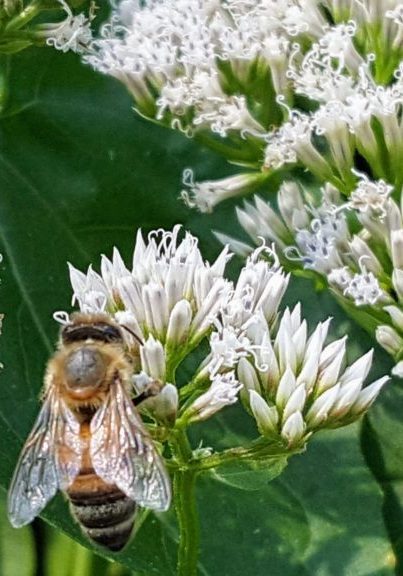
Bees forage from flowers to get both their pollen and nectar, their two sources of energy. Not all flowers provide both pollen and nectar for bees, some produce one or the other.
Bees use the pollen they collect to raise their young worker bees who have not yet even hatched from their cells . The pollen is a valuable source of protein for the bees. It provides exactly what bees need to grow.
Nectar on the other hand is the source of energy honeybees need to carry out their day to day activities. Without nectar, they wouldn’t survive each day and would actually starve very quickly.
Africanized honey bees eat the same way as the typical honey bee we are familiar with. Bumblebees, carpenter bees, solitary bees and all other types of bees forage on flowering plants just like our ordinary honeybees, the difference is how it is stored and how much.

Bees forage from flowers to get both their pollen and nectar, their two sources of energy. Not all flowers provide both pollen and nectar for bees, some produce one or the other.
Bees use the pollen they collect to raise their young worker bees who have not yet even hatched from their cells . The pollen is a valuable source of protein for the bees. It provides exactly what bees need to grow.
Nectar on the other hand is the source of energy honeybees need to carry out their day to day activities. Without nectar, they wouldn’t survive each day and would actually starve very quickly.
Africanized honey bees eat the same way as the typical honey bee we are familiar with. Bumblebees, carpenter bees, solitary bees and all other types of bees forage on flowering plants just like our ordinary honeybees, the difference is how it is stored and how much.
Honey Bees Eat Nectar
Honey Bees Eat Nectar
Nectar is the bees’ carbohydrate and provides the energy to stay alive. Aside from that, nectar has water, sugar, carbohydrates, amino acids, and proteins. It is a sweet fluid that flowers produce to attract bees and other pollinators.
Nectar is a mix of different sugars that are naturally found in the environment such as sucrose and glucose. When honey bees collect the nectar, it is mostly water and very thin.
While bees prefer to get nectar and sugar from flowers, they will at times visit drinks or anything that is sweet to them. This is why you will see them in the summertime circling trash cans.
Nectar is the bees’ carbohydrate and provides the energy to stay alive. Aside from that, nectar has water, sugar, carbohydrates, amino acids, and proteins. It is a sweet fluid that flowers produce to attract bees and other pollinators.
Nectar is a mix of different sugars that are naturally found in the environment such as sucrose and glucose. When honey bees collect the nectar, it is mostly water and very thin.
While bees prefer to get nectar and sugar from flowers, they will at times visit drinks or anything that is sweet to them. This is why you will see them in the summertime circling trash cans.
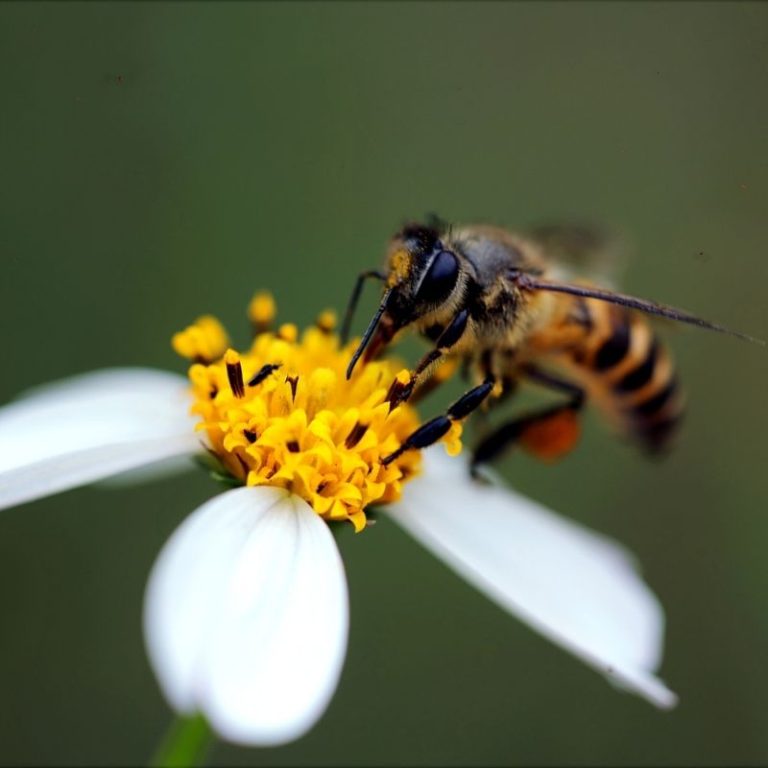
How Do Bees Collect The Nectar?
To get the sweet nectar to eat, bees use their complex mouthparts with a sort of straw. They use the straw called a proboscis to pull the nectar out of the flower. When bees drink the nectar, they store it in a pouch-like structure called a crop. They then regurgitate the nectar to other bees in the hive; this is the beginning of the honey-making process.
The worker bees are responsible for the whole nectar collecting and processing into honey. This honey becomes the fuel for the hive to raise brood, feed the queen and sustain daily life. Bees eat honey year around to support the

How Do Bees Collect The Nectar?
To get the sweet nectar to eat, bees use their complex mouthparts with a sort of straw. They use the straw called a proboscis to pull the nectar out of the flower. When bees drink the nectar, they store it in a pouch-like structure called a crop. They then regurgitate the nectar to other bees in the hive; this is the beginning of the honey-making process.
The worker bees are responsible for the whole nectar collecting and processing into honey. This honey becomes the fuel for the hive to raise brood, feed the queen and sustain daily life. Bees eat honey year around to support the
Bees Eat Pollen
Bees Eat Pollen
Pollen is a sticky, powder-like substance that comes from flowers. The color will vary greatly and can be yellow, orange, blue and purple. Pretty much any color you can think of, pollen can come in that color.
The bees search for flowers by a process called foraging. They can forage as far as 5 miles from their hives, but typically like to stay within a mile of their hive. Bees harvest pollen through specialized combs and brushes on the legs, abdomen and bodies.
Pollen is a sticky, powder-like substance that comes from flowers. The color will vary greatly and can be yellow, orange, blue and purple. Pretty much any color you can think of, pollen can come in that color.
The bees search for flowers by a process called foraging. They can forage as far as 5 miles from their hives, but typically like to stay within a mile of their hive. Bees harvest pollen through specialized combs and brushes on the legs, abdomen and bodies.
A bee moving from flower to flower picks up a lot of pollen. From the body, the pollen is moved to a special area on the hind legs called the pollen basket which are easy to notice on the back of the leg. Pollen baskets are often called pollen pants by beekeepers.
The bee can fit as much as 160,000 pollen granules in their pollen baskets. That is as much as one-third of its weight! An amazing thing is that the bee does every time it forages throughout the day.
A bee moving from flower to flower picks up a lot of pollen. From the body, the pollen is moved to a special area on the hind legs called the pollen basket which are easy to notice on the back of the leg. Pollen baskets are often called pollen pants by beekeepers.
The bee can fit as much as 160,000 pollen granules in their pollen baskets. That is as much as one-third of its weight! An amazing thing is that the bee does every time it forages throughout the day.
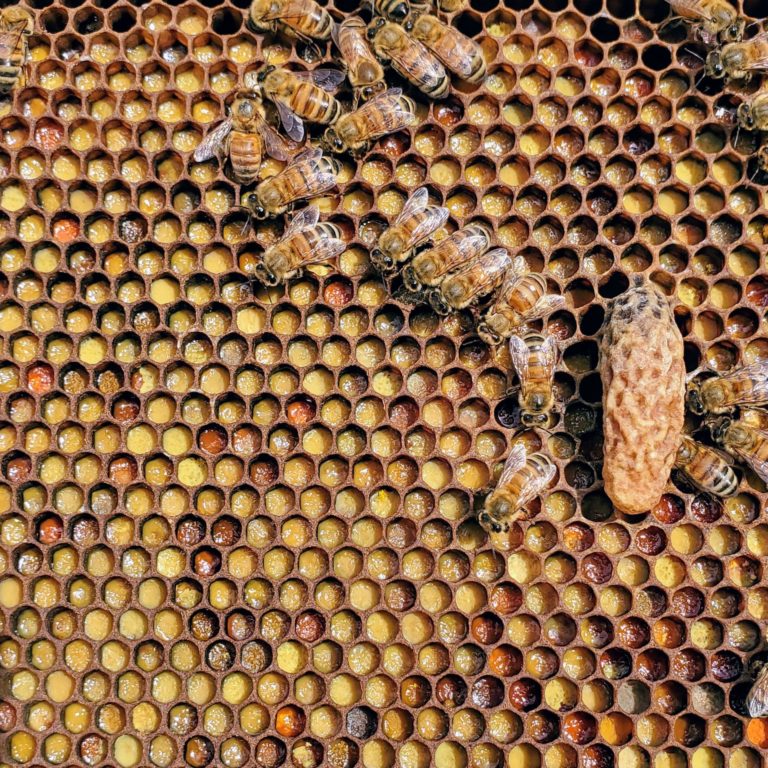
What Is Pollen Used For?
Pollen is the primary source of protein for bees, but the bees do not snack on any of the pollen on their way back home. It has to be brought back to the hive. Then, it is stored and shared with the colony as needed.
Pollen is what the bees feed to their larva to grow. Honey bees make something called bee bread with pollen. It is kind of like a sourdough starter. Honey bees mix nectar, pollen and enzymes from the bee.
It is left to slightly ferment before being fed to the larva. Bee bread is a nutritious and protein-rich food for the little ones to eat. The female worker bees feed the pollen to the growing larva, which is how most of the pollen is used. Worker bees and the queen will also eat the pollen as well.

What Is Pollen Used For?
Pollen is the primary source of protein for bees, but the bees do not snack on any of the pollen on their way back home. It has to be brought back to the hive. Then, it is stored and shared with the colony as needed.
Pollen is what the bees feed to their larva to grow. Honey bees make something called bee bread with pollen. It is kind of like a sourdough starter. Honey bees mix nectar, pollen and enzymes from the bee.
It is left to slightly ferment before being fed to the larva. Bee bread is a nutritious and protein-rich food for the little ones to eat. The female worker bees feed the pollen to the growing larva, which is how most of the pollen is used. Worker bees and the queen will also eat the pollen as well.
What Is Royal Jelly?
What Is Royal Jelly?
Honey bees will forage for nectar and pollen from the environment, but they do not collect royal jelly.
Royal jelly is a milky substance produced by honey bees and the queen is the only one that is fed royal jelly in large amounts. It is fed to the queen by worker bees who produce royal jelly from their head and feed it to very small larva while it grows. The queen is fed jelly as she grows in the cell. The queen bees are fed much more jelly than the ordinary honey bee female.
Honey bees will forage for nectar and pollen from the environment, but they do not collect royal jelly.
Royal jelly is a milky substance produced by honey bees and the queen is the only one that is fed royal jelly in large amounts. It is fed to the queen by worker bees who produce royal jelly from their head and feed it to very small larva while it grows. The queen is fed jelly as she grows in the cell. The queen bees are fed much more jelly than the ordinary honey bee female.
What Does Royal Jelly Do?
What Does Royal Jelly Do?
The jelly is a viscous substance. It can be compared to egg whites, but it is not quite the same. The jelly has an ingredient that is not found in egg whites known as royalactin . Royalactin helps with the growth of the queen bee and during development as a larva, turns her from a standard female worker bee into a fully developed queen bee with a reproductive system.
The jelly is a viscous substance. It can be compared to egg whites, but it is not quite the same. The jelly has an ingredient that is not found in egg whites known as royalactin . Royalactin helps with the growth of the queen bee and during development as a larva, turns her from a standard female worker bee into a fully developed queen bee with a reproductive system.
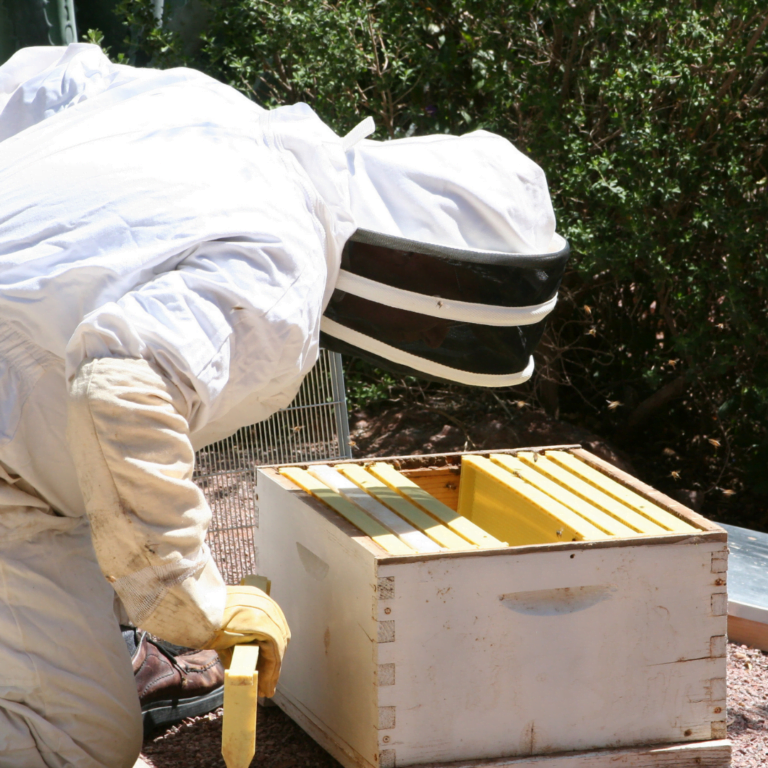
Where Does The Beekeeper Get The Honey?
Bees are some of the hardest working insects in nature. Because of that, they usually produce more honey than what they need.It is from this excess honey collected during the nectar flow that beekeepers typically harvest. We already know that this is stored at the top of the hive.
Beekeepers want to leave enough honey for bees to survive the winter during the winter dearth. Good beekeepers will leave the honey near the brood nest alone for the bees to eat.Make sure to leave some honey for the bees. They are really just sharing the fruits of their labors with us. We should not abuse their kindness.

Where Does The Beekeeper Get The Honey?
Bees are some of the hardest working insects in nature. Because of that, they usually produce more honey than what they need.It is from this excess honey collected during the nectar flow that beekeepers typically harvest. We already know that this is stored at the top of the hive.
Beekeepers want to leave enough honey for bees to survive the winter during the winter dearth. Good beekeepers will leave the honey near the brood nest alone for the bees to eat.Make sure to leave some honey for the bees. They are really just sharing the fruits of their labors with us. We should not abuse their kindness.
Storing Honey And Pollen Inside The Hive
Storing Honey And Pollen Inside The Hive
Bees use the same cells they use for raising their brood (baby bees) as they do for storing their food. In these cells, they will pack pollen as well as the honey. Bees are very organized in how they store their food. Much of the pollen for feeding the larva is stored near the larva.
This makes it easy for them to access it. The excess honey is stored on the top of the colony where there is extra room.
We will find out later that this excess honey is not only good for bees to eat. It is important that bees have extra honey during the winter, as honey bees rely on these liquid sweets and pollens during the winter.
Bees use the same cells they use for raising their brood (baby bees) as they do for storing their food. In these cells, they will pack pollen as well as the honey. Bees are very organized in how they store their food. Much of the pollen for feeding the larva is stored near the larva.
This makes it easy for them to access it. The excess honey is stored on the top of the colony where there is extra room.
We will find out later that this excess honey is not only good for bees to eat. It is important that bees have extra honey during the winter, as honey bees rely on these liquid sweets and pollens during the winter.
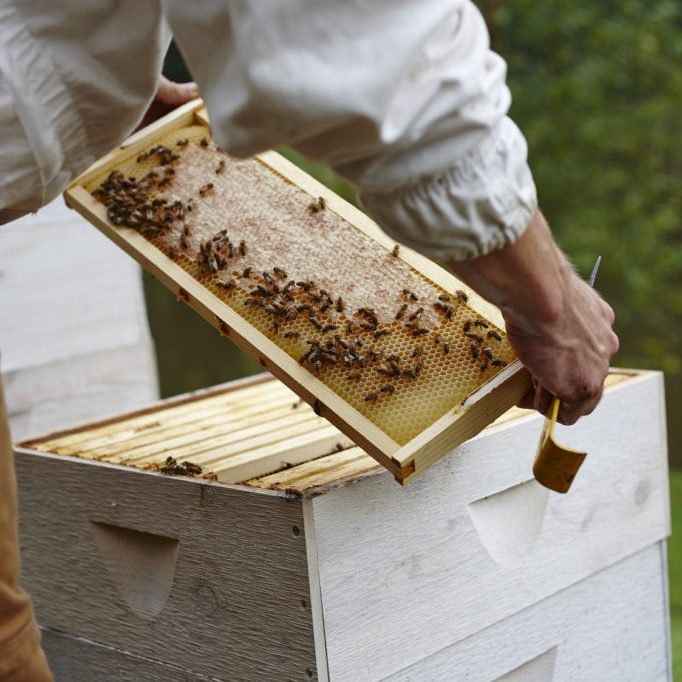
How Do Bees Make Their Honey?
So where does honey come into play? Honey is nectar that has been concentrated down and partially processed by the bee to make it easier to digest.
Bees collect extra nectar from hives and reduce it down to roughly 20% of its original volume. Then they store it away to be used later.
Bees will flap their wings, creating an air current inside the hive. They work as a team to evaporate the water out of the nectar. This team effort is what allows them to remove all that water.
What Do Bees Do With Honey?
As much as we love honey, honey bees don’t make honey for us. Bees store extra honey during the spring and summer while there are a lot of flowers blooming. They do this so that they can eat it during the winter when flowers are not blooming. That is why the best beekeepers only harvest the excess honey and leave the rest for the bees to eat during winter during the nectar dearth.

How Do Bees Make Their Honey?
So where does honey come into play? Honey is nectar that has been concentrated down and partially processed by the bee to make it easier to digest.
Bees collect extra nectar from hives and reduce it down to roughly 20% of its original volume. Then they store it away to be used later.
Bees will flap their wings, creating an air current inside the hive. They work as a team to evaporate the water out of the nectar. This team effort is what allows them to remove all that water.
What Do Bees Do With Honey?
As much as we love honey, honey bees don’t make honey for us. Bees store extra honey during the spring and summer while there are a lot of flowers blooming. They do this so that they can eat it during the winter when flowers are not blooming. That is why the best beekeepers only harvest the excess honey and leave the rest for the bees to eat during winter during the nectar dearth.
Honeybees store excess honey for the winter, way more than they need. This is one thing that sets European honey bees apart from other types of bees.
Bees need honey to survive the periods when plants are not producing nectar. This is usually during winter and the heat of the summer. In some places like Florida, the bees are typically able to fly all year long since something is blooming year around. In other places like Michigan, bees cannot fly all year. They cannot fly for long when outdoor temperatures are below 55°F.
This means that they have to eat whatever they save. If they do not save enough, they will not survive the winter. Beekeepers will often feed bees sugar if they are at risk of starving.
Honeybees store excess honey for the winter, way more than they need. This is one thing that sets European honey bees apart from other types of bees.
Bees need honey to survive the periods when plants are not producing nectar. This is usually during winter and the heat of the summer. In some places like Florida, the bees are typically able to fly all year long since something is blooming year around. In other places like Michigan, bees cannot fly all year. They cannot fly for long when outdoor temperatures are below 55°F.
This means that they have to eat whatever they save. If they do not save enough, they will not survive the winter. Beekeepers will often feed bees sugar if they are at risk of starving.
Do Bees Drink Water?
Do Bees Drink Water?
Yes, honey bees gather water from the environment. Worker bees drink water from puddles, lakes and any other natural water source. Older bees are responsible for foraging for water, just as they are responsible for foraging for nectar and pollen.
Oddly enough, honey bees like dirty water over clean water which is really interesting. Bees will actually go to the exact same spot to forage for water, even landing on the same rock each time.
They also need more water in summer than winter. This is why it is important to use water to cool down the hive during the summer so your bees will not die of thirst.
Yes, honey bees gather water from the environment. Worker bees drink water from puddles, lakes and any other natural water source. Older bees are responsible for foraging for water, just as they are responsible for foraging for nectar and pollen.
Oddly enough, honey bees like dirty water over clean water which is really interesting. Bees will actually go to the exact same spot to forage for water, even landing on the same rock each time.
They also need more water in summer than winter. This is why it is important to use water to cool down the hive during the summer so your bees will not die of thirst.
Finishing Up
Finishing Up
The honey bee is a fascinating creature that plays an integral role in the world of food production. We have discussed how bees consume nectar and pollen and how they use it inside their hive. It’s incredibly important to the survival of our honey bees and we must do what we can to protect our environment so honeybees and other pollinators can remain well fed.
The honey bee is a fascinating creature that plays an integral role in the world of food production. We have discussed how bees consume nectar and pollen and how they use it inside their hive. It’s incredibly important to the survival of our honey bees and we must do what we can to protect our environment so honeybees and other pollinators can remain well fed.
